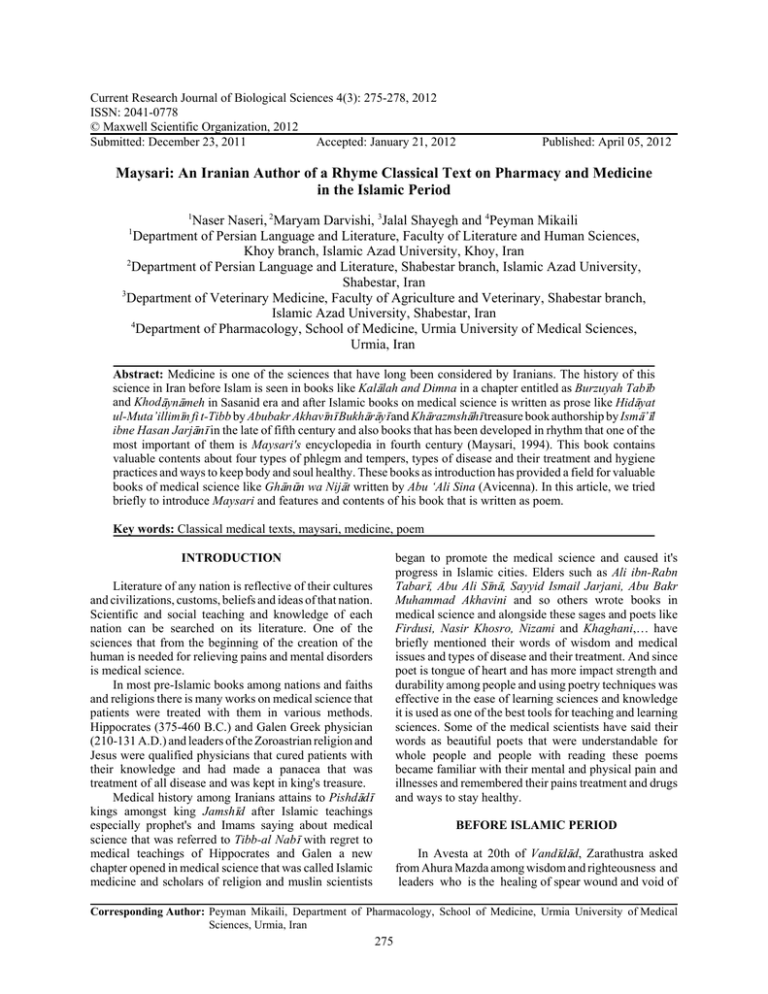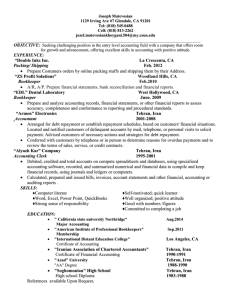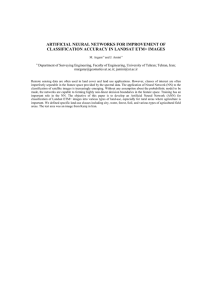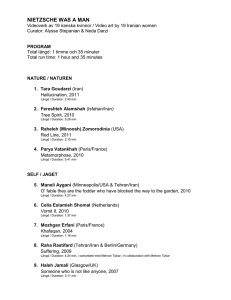Current Research Journal of Biological Sciences 4(3): 275-278, 2012 ISSN: 2041-0778
advertisement

Current Research Journal of Biological Sciences 4(3): 275-278, 2012 ISSN: 2041-0778 © Maxwell Scientific Organization, 2012 Submitted: December 23, 2011 Accepted: January 21, 2012 Published: April 05, 2012 Maysari: An Iranian Author of a Rhyme Classical Text on Pharmacy and Medicine in the Islamic Period 1 Naser Naseri, 2Maryam Darvishi, 3Jalal Shayegh and 4Peyman Mikaili Department of Persian Language and Literature, Faculty of Literature and Human Sciences, Khoy branch, Islamic Azad University, Khoy, Iran 2 Department of Persian Language and Literature, Shabestar branch, Islamic Azad University, Shabestar, Iran 3 Department of Veterinary Medicine, Faculty of Agriculture and Veterinary, Shabestar branch, Islamic Azad University, Shabestar, Iran 4 Department of Pharmacology, School of Medicine, Urmia University of Medical Sciences, Urmia, Iran 1 Abstract: Medicine is one of the sciences that have long been considered by Iranians. The history of this science in Iran before Islam is seen in books like Kal~lah and Dimna in a chapter entitled as Burzuyah Tab§b and Khod~yn~meh in Sasanid era and after Islamic books on medical science is written as prose like Hid~yat ul-Muta’illim§n fi t-Tibb by Abubakr Akhav§n§ Bukh~r~y§ and Kh~razmsh~h§ treasure book authorship by Ism~’§l ibne Hasan Jarj~n§ in the late of fifth century and also books that has been developed in rhythm that one of the most important of them is Maysari's encyclopedia in fourth century (Maysari, 1994). This book contains valuable contents about four types of phlegm and tempers, types of disease and their treatment and hygiene practices and ways to keep body and soul healthy. These books as introduction has provided a field for valuable books of medical science like Gh~nãn wa Nij~t written by Abu ‘Ali Sina (Avicenna). In this article, we tried briefly to introduce Maysari and features and contents of his book that is written as poem. Key words: Classical medical texts, maysari, medicine, poem INTRODUCTION began to promote the medical science and caused it's progress in Islamic cities. Elders such as Ali ibn-Rabn Tabar§, Abu Ali S§n~, Sayyid Ismail Jarjani, Abu Bakr Muhammad Akhavini and so others wrote books in medical science and alongside these sages and poets like Firdusi, Nasir Khosro, Nizami and Khaghani,… have briefly mentioned their words of wisdom and medical issues and types of disease and their treatment. And since poet is tongue of heart and has more impact strength and durability among people and using poetry techniques was effective in the ease of learning sciences and knowledge it is used as one of the best tools for teaching and learning sciences. Some of the medical scientists have said their words as beautiful poets that were understandable for whole people and people with reading these poems became familiar with their mental and physical pain and illnesses and remembered their pains treatment and drugs and ways to stay healthy. Literature of any nation is reflective of their cultures and civilizations, customs, beliefs and ideas of that nation. Scientific and social teaching and knowledge of each nation can be searched on its literature. One of the sciences that from the beginning of the creation of the human is needed for relieving pains and mental disorders is medical science. In most pre-Islamic books among nations and faiths and religions there is many works on medical science that patients were treated with them in various methods. Hippocrates (375-460 B.C.) and Galen Greek physician (210-131 A.D.) and leaders of the Zoroastrian religion and Jesus were qualified physicians that cured patients with their knowledge and had made a panacea that was treatment of all disease and was kept in king's treasure. Medical history among Iranians attains to Pishd~d§ kings amongst king Jamsh§d after Islamic teachings especially prophet's and Imams saying about medical science that was referred to Tibb-al Nab§ with regret to medical teachings of Hippocrates and Galen a new chapter opened in medical science that was called Islamic medicine and scholars of religion and muslin scientists BEFORE ISLAMIC PERIOD In Avesta at 20th of Vand§d~d, Zarathustra asked from Ahura Mazda among wisdom and righteousness and leaders who is the healing of spear wound and void of Corresponding Author: Peyman Mikaili, Department of Pharmacology, School of Medicine, Urmia University of Medical Sciences, Urmia, Iran 275 Curr. Res. J. Biol. Sci., 4(3): 275-278, 2012 a study at Yaghm~ magazine, no 12, mentions the approximate date of writing this book a few years before 370 that this is the date of writing the encyclopedia of sage Maysari (Akhavini, 1965). In this book the writer mentioned so detailed to the quadruplet, phlegm, tempers, body organs, types of physical and mental illnesses factors and their treatment and types of fever and pulse. Nezami Uruzi samarghandi the owner of ChaharMaghaleh book that have assigned one chapter of it to medical science recommends reading of this book to all of the physicians (Nezami Uruzi, 1993). Muhammad ibni-Zakariyaye R~zi one of the scientists of 3th century AH (10th AD) has wrote many books in medical that the most important of them are Alhavi, Alshukuk, Alfusul fi tibb Mizarulaghziyeh (Moin,1992). Ibn Sina is another Iranian scientist who wrote books on medical science that the most famous of them is Ghanun al-nijat. Dr. Moin writes" Gh~nãn is a book on Islamic medicine that is in Arabic and it is the most detailed book of Ibni-Sina and was taught in Islamic and European countries for years. It is written about 403 to 414 years AH and it was considered as textbook of medicine in Europe including Minpiliyeh and Lurn (Moin, 1992). Kharazmshahi treasure book is a detailed book in Persian including all parts of old medical science written by Ismail ibni Hasan Jarjani in year 504 AH and is one of the most important books of Islamic medicine. Several copies of this book are in European countries (Maysari, 1994). Introduction of Maysari and his encyclopedia. Maysari as he says is Iranian born and probably from Khorasan region and wrote his famous medical work in Persian, he himself mentions to the year of writing this book that was in year 504 AH and that time he was 46 years old. Maysari was an experienced physician and was very skillful in treating patients and examining drugs. He was a Muslim and believed in principles of religion and began his medical encyclopedia with praise of god and applauding dignified prophet and praised householders and mixed knowledge of bodies with knowledge of religions, he considers astronomy, mathematics, medicine and religion the main knowledge but from these mentions medicine and religion chosen knowledge and believes that without a healthy body it is not possible to learn medical science and not knowing the medical science will lead to loss world and hereafter. Knowing medicine saves your body and knowing religion saves your soul (Maysari, 1994). He believes that in his book he has expressed all disease's names and their treatment in various forms like nerve, belly and hemorrhoid drugs, types of syrups, dressings, suppositories, dermatological drugs, oily, Opium, antidote and foods and says: I mentioned to all disease and their treatment and made happy very sad magic? Answered: O Zarathustra, Tharite among leaders and people is the first person that is curing and void of magic and keeps away disease and death and fervor from people (Najm Abadi, 1996; Molavi, 2001). It is mentioned in Zoroastrians bible that Ahura Mazda gave an ornate knife to Tharite to perform surgery and be informed from the properties of medicinal plants and their extracts (pp:108). Except Tharite name of two persons is seen in medical history of ancient Persia one yema and the other Thraetaona that former could separate patients with dermal, bone and dental disease from healthy people and the latter is astronomer and maker of wax and opium (pp:108). Kalileh and Dimna that has Indian root is brought to Iran in Sasanid era and is translated into middle Persian by Burzuye Tabib. He adds some chapters to it that one of them is about medical science. In this regard he writes: when I was seven years old my parents encouraged me to study medical science and when I knew it's virtue worked in its learning with true interest and prevail greed and in this work I became famous and came to treat patients (Minavi, 2001). One of the most beautiful aspects of ancient Persia's medicine that is accompanied by surgery and anesthesia is born of Persian paladin, Rostam, that because of his huge size in his mother's abdomen it was not possible to give birth naturally and so inevitably with wine and anesthetic drugs made Roodabeh Rostam's mother unconscious and torn her stomach and after giving birth stitched the wound and made dressing for wound healing. Firdausi at Shahnameh (Firdusi, 1995) is mentioned to this event beautifully that Z~l asks for help from Simurgh and he teaches the approach of child birth and reminds him to use milk and musk and special herbals for wound and in this regard he says: bring spirits dagger and a sighted man/first drunk Rudabi with wine/keep away fear and worry from your heart/she would not feel pain/tear her stomach and bring out child/then sew torn apart and keep away fear and apprehension from your heart/make a drug with milk and musk and put it on her wound/and you will see that it would heal her wound/a skilled Zoroastrian priest came and made Rudabi drunk with wind/he torn her stomach and child's head came out/he bring out child very easily that no one had seen such a wonder yet! That it is the same thing that today surgeons operate and call it version. Embalm the dead was one of the old medical affairs that in the shahnameh's stories are many signs related and they took advantage of musk, camphor and rosewater for emblam. MEDICINE IN IRAN OF THE ISLAMIC PERIOD Hidayat ul-muta’allimin fi t-Tibb is one of the oldest Persian prose works that belongs to 4th century AH. The author is a physician from Bukhara under the name Abubakr Rabi-ibn Ahmad Akhavini. Mojtaba Minavi in 276 Curr. Res. J. Biol. Sci., 4(3): 275-278, 2012 In his opinion anyone who feels itching in his anal is suffering from hemorrhoids that sometimes causes bleeding (Maysari, 1994). hearts (Maysari, 1994). He believes that if grace and divine wisdom were not accompanied with physicians, drugs wouldn't work and says: you can cure no patient without God's help (Maysari, 1994). And in his opinion God created hundreds of treatment for one pain and there is no pain without treatment. The God that gave us pain created hundreds of treatment for each pain (Maysari, 1994). Also Mulavi in story of king and bondmaid believes that king brings the most qualified physicians to patients beside and physicians were proud of their knowledge and forgot God's grace and thus not only their treatments didn't work but also had a reverse result. In this regard, Mulavi says: Because they didn't say "if god wills" so god made them unable (Molavi, 2001). Recognition of phlegm and temper in Maysari encyclopedia Pregnancy signs and prevention methods and health importance: Maysari describes pregnancy symptoms of women like this: closed and without discharge cervix, no menses, most of the times sleepy and freckles are seen in her face (Maysari, 1994). And about preventing pregnancy he says Piyeh and Hanzal (a bitter herbal) should be mixed and used like suppository. And for abortion a woman should regularly eat gorse for one week and if it didn't work she can use sap of Ghatran and Hanzal (Maysari, 1994). In his opinion the way of detecting good milk from bad milk is to pour a drop of milk on nail if it is so dark or so light it is not a good milk but if it is light and concentrated it is a good milk (Maysari, 1994). In ancient medical books on definition of phlegm and temper is written: Temperament is such a quality that is created from cross-reactive of opposite components like mixture of fever with aloofness. In summary from mixing, these natural components a quality occurs that we call it temper (Abu al-Hab§b, 2008). "and phlegm is a flow mixture in human's body that it's natural place is inside vessels and organs that between them is empty, kike belly and liver and spleen and gallbladder" (Jarjani, 2005). Definitions of human's tempers from the Maysari's point to view: human's heart has a hot temper and in terms of warmth and heat is like liver. And the cause of hearts hot temper is blood. People's heart is always hot/liver and heart are both hot temper (Maysari, 1994). Whoever that is cold-temper is a weak, thin and pale peraon and his pulse beats weak. When a person is cold-temper pulse is always weak and he is pale (Maysari, 1994). In his opinion cold-temper persons undoubtedly have these features: weak pulse, late digestion, late gastric digestion and low libido in contrast hot-temper persons have rapid pulse, early gastric digestion, and high libido (Maysari, 1994).In his opinion a person that has infection in his body has red and very bad-smelling urine (Maysari, 1994). In his opinion fat people suffer from different disease and asthma and sudden death is waiting for them (Maysari, 1994). In his opinion thin people must prevent tuberculosis and percussion because they are prone to melancholy. Thin people fear from tuberculosis and percussion/and they are prone to melancholy (Maysari, 1994). In his opinion excessive sweating is a sign of aging and the person is always at risk of dangerous stroke. Excessive sweating is a sign of aging/and stroke occurs in aging (Maysari, 1994). DISEASE AND THEIR TREATMENT Cholera: Based on Maysari's opinion this disease mostly occurs at summer and early fall and it's cause is lack of rain and wine and whoever coughs cholera should not eat sweetmeat, wine, and meat (Maysari 176). And he recommends patients involved with cholera not to go to bath. And beware of eating fruits and heat and believes that sour water and rhubarb and pomegranate and eating a mixture of water and vinegar is useful for patients and says: disinfect everywhere of home with vinegar. Mix water and vinegar/then eat it and distinct home with it (Maysari, 1994). And knows camphor pills a preventive factor for this disease. Eat camphor pills that it saves you from cholera (Maysari, 1994). Smallpox: It is a viral and highly contagious disease which in its preliminary stage presents with non-special signs, such as fever, headache, backache and vomiting, and then it is accompanied with dermatological manifestations. In Maysari's opinion symptoms of cholera are red eyes, high fever, headache, backache and itchy nose (Maysari, 1994). He believes that a cholera patient should rest and try bleed or phlebotomy (Maysari, 1994). Rabies: It is an acute and fatal disease, which involves the central nervous system. The transmission routes include biting of rabid animals, eroded skins, mucosal membranes, respiratory pass ways, tissue transplantation, gastrointestinal, placental and contaminated materials (Abedi, 2003). He believes that if someone is bitten by a dog and ulcers and bleeding occurred the person should mix onion, honey and salt and use it as dressing and if wound is severe it should be washed by vinegar and salt (Maysari, 1994). 277 Curr. Res. J. Biol. Sci., 4(3): 275-278, 2012 Diarrhea: Maysari for diarrhea treatment recommends eating pomegranate juice, magnesium and rose at dawn and believes that sumac is a useful in Galenic pharmacy for diarrhea treatment and also cooked rice in milk is useful (Abyat p 130). most of them not only in Islamic schools but also in European universities were counted as the most important medical books. Meningitis: Avicenna in definition of meningitis says: meningitis in inflammation of the thin and thick curtains of the brain that is usually without inflammation of brain tissue but sometimes may be associated with it. He believes that the worst type of meningitis is when it origins from pneumonia and accompanies with convulsion and brick-colored sputum (Tabatabi, 1998). This course is now approved by physicians. Maysari for treatment of migraine or meningitis recommends venipuncture, camphor and sandalwood (Maysari, 1994). Abedi, G., 2003. The Most Common Contagious and Non-Contagious Disease. Abedi far Publication, Tehran. Abu al-Hab§b, S.A., 2008. Traditional Medicine, a Nutrition Course. Mahru Publication, Tehran. Akhavini, R.I.A., 1965. Hidayat ul-Mutallimin FIT-Tibb. Dedication to the Doctor Jalal Matini, Tehran's University Publication, Tehran. Firdusi, A., 1995. Shahnameh, efforts of Mahmud Roshan and Mehdi Gharib., Fakhteh Publication, Tehran. Jarjani, I.I.H., 2005. Kharazmshahi Treasure, Efforts of Mohammad Taghi Danesh Pajouh and Iraj Afshar. Allmaleh Publication, Tehran. Maysari, 1994. Encyclopedia of Medicine by Dedication to the Dr. Barat Zanjani. Tehran's University Publication, Tehran. Minavi, M., 2001. Medicine History in Iran. Tehrans University Publication, Tehran. Moin, M., 1992. Moin Encyclopedia. Amir Kabir Publication, Tehran, Vol. 6. Molavi, J.I., 2001. Masnav§ (Forozanfar Description). Scientific and Cultural Publication, Tehran. Najm Abadi, M., 1996. Medicine History in Iran. Tehrans University Publication, Tehran. Nezami Uruzi, A.I.U., 1993. Chaharmaghaleh, Allama Mohammad Ghazvini Correction. Fakhteh Publication, Tehran. Tabatabi, M., 1998. Research on some fundamental issues in traditional medicine. Medicine and refinement, no 28. REFERENCES CONCLUSION Deliberation on pre-Islamic works reflects this fact that medical science since long ago alongside other nations is considered by scientists, physicians, and priests in Iran. Zoroastrian priests, Jesus, Physicians like Thariteh and Hippocrates and Galen had treated and cured patients. In a narrative of Zarathustra bible Ahura Mazda gave knife ornamented with jewelry to Thariteh that had operated surgery with it and Rostam is born by surgery. After Islam several books has been written by Muslim physicians in medical science that most of them was as rhyme. Maysari's book is written in rhyme method in the fourth century AH. This book is reflective of medical science about types of disease and their treatments in fourth century AH. These books are creation base of Avicenna's valuable books in medical science that 278


![Amir Shams [ card ] 02](http://s2.studylib.net/store/data/005340099_1-e713f7ae67edd60d4c53ae5bb9448166-300x300.png)



